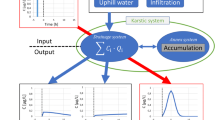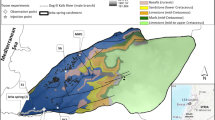Abstract
Reactive tracer tests are performed to derive flow, transport and in situ biodegradation parameters. This paper describes the 3D simulation of a reactive tracer test using the transition probability geostatistical approach. Fifty different equally probable aquifer realizations were generated based on the geological information of 107 boreholes in an area of 62,500 m2. One realization was chosen for the reactive transport simulation based on the results of groundwater flow modeling and on particle tracking calculations for the site. Field velocities at the site vary between 0.4 and 3 m/d. The transport of the reactive tracers deuterium ring labeled toluene-d5 and fully deuterated toluene-d8 was simulated and first-order biodegradation rates of 0.017 d−1 for toluene-d5 and 0.012 d−1 for toluene-d8 were determined.










Similar content being viewed by others
References
Boggs JM, Adams EE (1992) Field study of dispersion in a heterogenous aquifer. 4. Investigation of adsorption and sampling bias. Water Resour Res 28(12):3325–3336
Brouyere S, Carabin G, Dassargues (2005) Influence of injection conditions on field tracer experiments. Ground Water 43(3):389–400
Carle SF, Fogg GE (1996) Transition probability-based indicator geostastics. Math Geol 28(4):453–476
Carle SF, Fogg GE (1997) Modeling spatial variability with one- and multi-dimensional continous Markov chains. Math Geol 29:231–244
Davis JA, Kent DB, Coston JA, Hess KM, Joye JL (2000) Multispecies reactive tracer test in an aquifer with spatially variable chemical conditions. Water Resour Res 36(1):119–134
Essaid HI, Cozzarelli IM, Eganhouse RP, Herkelrath WN, Bekins BA, Delin GA (2003) Inverse modeling of BTEX dissolution and biodegradation at the Bemidjii, MN crude-oil spill site. J Contam Hydrol 67:269–299
Fischer A, Bauer J, Meckenstock R, Stichler W, Griebler C, Maloszewski P, Kästner M, Richnow HH (2006) A multitracer test proving the reliability of stable isotope fractionation analysis for assessing anaerobic degradation in a BTEX contaminated aquifer. Environ Sci Technol 40(13):4245–4252
Gödeke S, Weiss H, Geistlinger H, Fischer A, Richnow HH, Schirmer M (2004) Natural Attenuation Standort Zeitz: Strömungs- und Tracertransportmodellierung. Grundwasser 1(9):3–11
Gödeke S, Richnow HH, Weiß H, Fischer A, Vogt C, Borsdorf H, Schirmer M (2006) Multi component-reactive tracer test for the implementation of enhanced in-situ bioremediation at a BTEX-contaminated megasite. J Contam Hydrol 87(3–4):211–236
Harbaugh AW, Banta ER, Hill MC, McDonald MG (2000) MODFLOW-2000, the U.S. Geological Survey modular ground-water model—user guide to modularization concepts and the ground-water flow process: U.S. Geological Survey Open-File Report 00–92, 121 p
Hess KM, Davis JA, Kent DB, Coston JA (2002) Multispecies reactive tracer test in an aquifer with spatially variable chemical conditions, Cape Cod, Massachusetts: Dispersive transport of bromide and nickel. Water Resources Research, 38(8). doi:10.1029/2001WR000945
Leonard BP (1988) Universal Limiter for Transient Interpolation: Modeling of the Advective Transport Equations: The ULTIMATE Conservative Difference Scheme, Technical Memorandum 100916 ICOMP-88-11, NASA, Washington, DC
Maloszewski P, Zuber A, Bedbur E, Matthess G (2003) Transport of three Herbicides in Ground Water at Twin Lake Test Site, Chalk River, Ontario, Canada
Morasch B, Richnow HH, Schink B, Meckenstock RU (2001) Stable hydrogen and carbon isotope fractionation during microbial toluene degradation: Mechanistic and environmental aspects. Appl Environ Microbiol 67:4842–4849
Pollock DW (1994) User`s Guide for Modpath/Modpath-Plot, Version 3: A Particle Tracking Post-Processing Package for Modflow, the U.S. Geological Survey Finite-Difference Ground-Water Flow Model (Open-File Report No. 94–464). U.S. Geological Survey
Rubin Y (2003) Applied stochastic hydrogeology. Oxford University Press, New York
Schirmer M, Richnow HH, Gödeke S, Schirmer K, Weiß H, Dahmke A, Teutsch G (2006) Natural attenuation research at the contaminated Megasite Zeitz. J Hydrol 328(3–4):393–407
Stenback GA, Ong SK, Rogers SW, Kjartanson BH (2004) Impact of transverse and longitudinal dispersion on first-order degradation rate constant estimation. J Contam Hydrol 73:3–14
Suarez MP, Rifai HS (1999) Biodegradation Rates for fuel Hydrocarbons and chlorinated solvents in groundwater. Bioremidiat J 3(4):337–362
Vieth A, Kästner M, Schirmer M, Weiß H, Gödeke S, Meckenstock RU, Richnow HH 2005: In-situ biodegradation of benzene and toluene in a contaminated aquifer monitored by stable isotope fractionation. Environ Toxicol Chem 24(1):51–60
Weissmann GS, Fogg GE (1999) Multi-scale alluvial fan heterogeneity modeled with transition probability geostatistics in a sequence stratigraphic framework. J Hydrol 226:48–65
Weissmann GS, Carle SF, Fogg GE (1999) Three-dimensional hydrofacies modeling based on soil surveys and transition probability geostatistics. Water Resour Res 35:1761–1770
Zheng C, Wang PP (1999) MT3DMS: A modular three-dimensional multispecies model for simulation of advection, dispersion and chemical reactions of contaminants in groundwater systems: Documentation and user`s guide. Contract Report SERDP-99-1.Vicksburg, Mississippi: U.S. Army Engineer Research and Development Center
Zheng C, Gorelick SM (2003) Analysis of Solute Transport in Flow Fields Influenced by Preferential Flowpaths at the Decimeter Scale. Ground Water 41(2):142–155
Acknowledgments
We would like to thank our co-workers from the RETZINA Project team for their excellent co-operation. We are grateful for the funding of the RETZINA Project by the German Federal Ministry of Education and Research (BMBF) under reference numbers 02WT0040, 02WT0041 and 02WT0042. Additional funding for the project has been provided through the SAFIRA I (Remediation research in regionally contaminated aquifers) Project of the UFZ. We thank Holger Weiß (UFZ) for supporting the tracer test. We thank Olaf Böhme (GFE-Consult GmbH, Halle, Germany) and Ralf Trabitzsch (UFZ) for the site management. We thank Jasmine Rutherford (URS Corporation) for reviewing the manuscript. Product names are only mentioned for identification purposes.
Author information
Authors and Affiliations
Corresponding author
Rights and permissions
About this article
Cite this article
Gödeke, S., Geistlinger, H., Fischer, A. et al. Simulation of a reactive tracer experiment using stochastic hydraulic conductivity fields. Environ Geol 55, 1255–1261 (2008). https://doi.org/10.1007/s00254-007-1073-3
Received:
Accepted:
Published:
Issue Date:
DOI: https://doi.org/10.1007/s00254-007-1073-3




